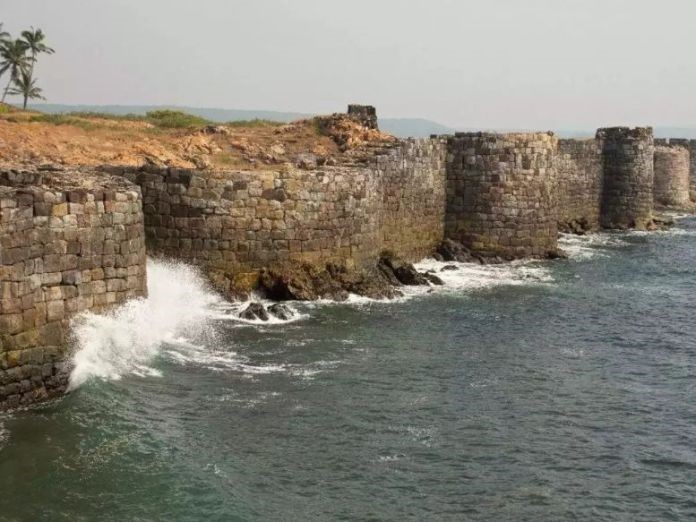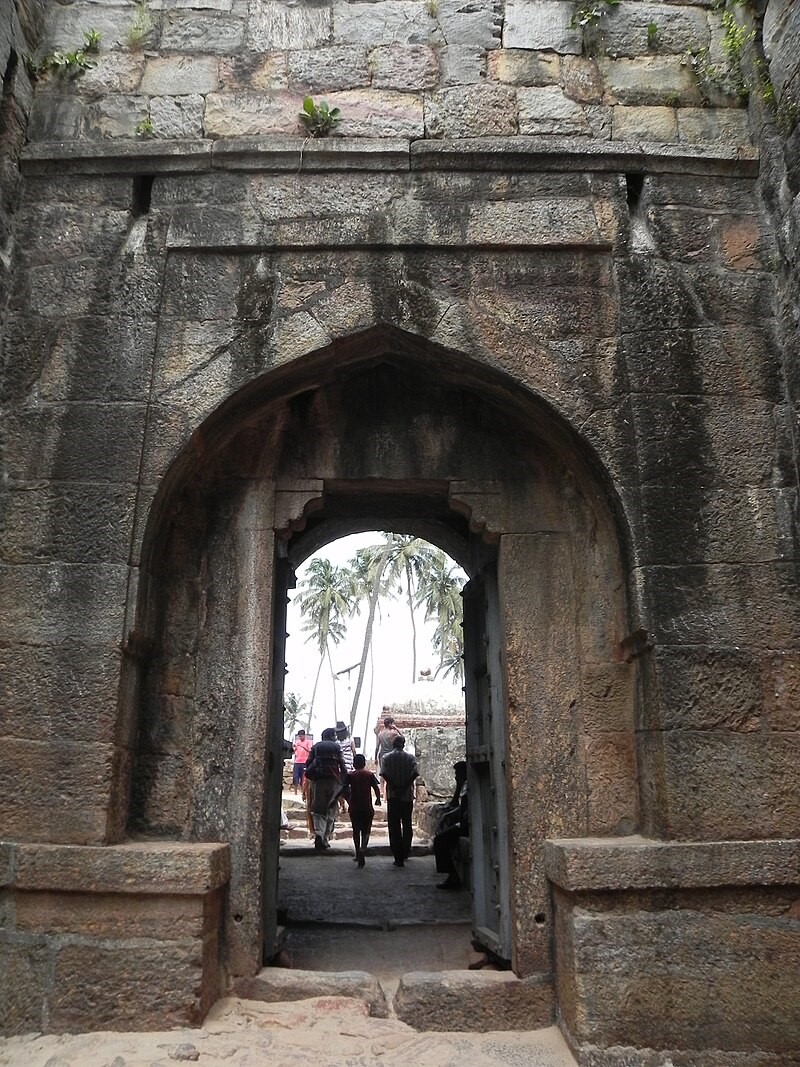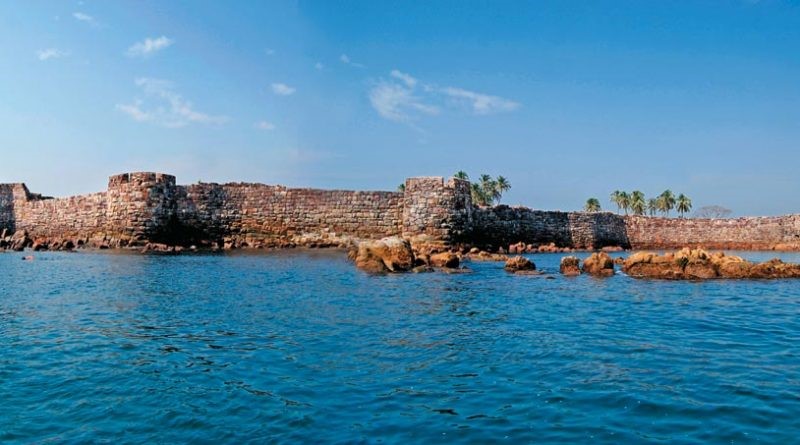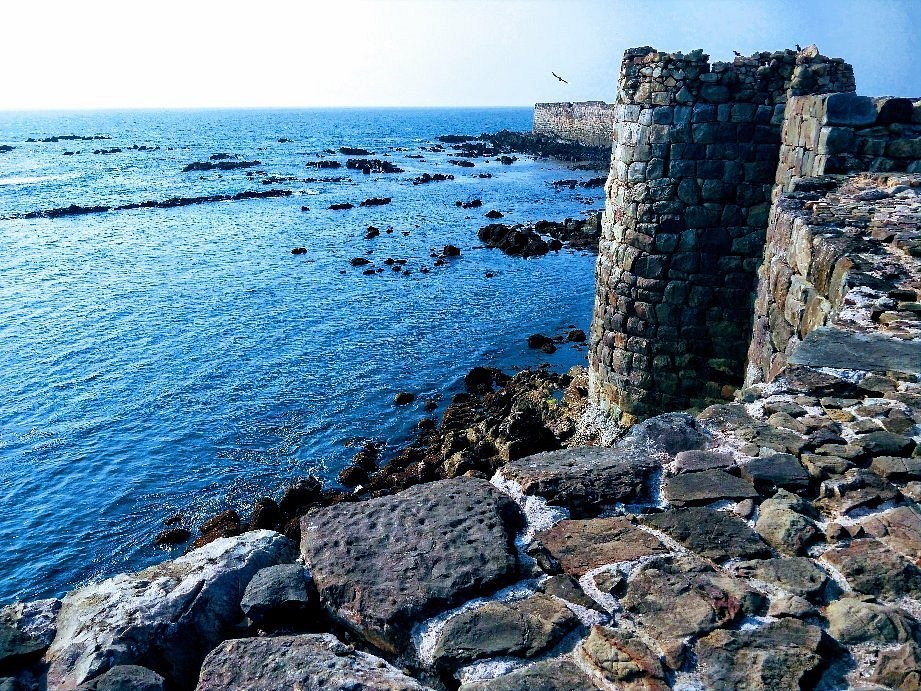- Private car and driver in Delhi / India
- +91-8447445445
- info@discoverindiabycar.com sugar.ankit@yahoo.com
 +91-9818434712
+91-9818434712
Discover the history of Sindhudurg fort
The stunning citadel on the Arabian Sea, Sindhudurg Fort, is located off the coast of Maharashtra, India. This fort is situated on a rocky island known as Kurte. Chhatrapati Shivaji Maharaj, the Maratha emperor, oversaw the fort’s construction, which started in the latter part of the 17th century. Its goal was to thwart naval assaults on the Maratha Empire by the British, Dutch, and Portuguese. Its defenses consisted of strong bastions and enormous walls. The fort’s enormous defensive holes that surround it are evidence of the Maratha people’s extraordinary engineering prowess. There’s a meandering, zigzag path that leads to the secret main entrance. Shivaji’s hand and footprints are visible on one of the walls, and a nearby temple is dedicated to the Maratha deity Bhavani.
Sindhudurg Fort, constructed by none other than Chhatrapati Shivaji, makes use of the natural cover that the nearby rocks offer. This stronghold, with its magnificent gates and sturdy walls, is both a well-known tourist destination and an intriguing historical relic. The massive fort’s ability to withstand the ages may have something to do with its distinct and exacting construction method. The foundation of the gigantic fortress was erected first, and the surrounding rocks served as an impenetrable natural barrier to keep out any attackers who might attempt to damage it. The 42 bastions of Sindhudurg Fort, which is surrounded by smaller forts like Padmagad, Rajkot, and Sarjekot Forts, are still standing. A small temple honoring the Chhatrapati is located among the exterior walls of the fort.
The past and current of Sindhudurg Fort

Sindhudurg Fort belonged to the Maratha Empire until the British took control of it in 1765. Chhattrapati Shivaji ordered its construction in an attempt to check the rising of the Siddis of Janjira and to counter the growing influence of traders from the English, Dutch, French, and Portuguese. Hirojee Indulkar put close supervision on the construction of the same monument in 1664. Eventually, the British were able to take it and rename it. At some point following, Port Augustus. It then passed to the Marathas, who finally subdued it in 1792 in accordance with the terms of the British-Maratha pact. When you visit this magnificent fort, which is steeped in history and provides a breathtaking perspective of the surrounding countryside, you will undoubtedly sense the aura of mystery.
The building components of Sindhudurg Fort

The strength of Sindhudurg Fort can be attributed to its unwavering engineering, which made significant use of indigenous materials, showcasing their best attributes. The fort was constructed using an enormous quantity of sand that was first transported from Gujarat. The walls of Sindhudurg Fort stand thirty feet high and twelve feet thick, making them nearly impregnable. A further deterrent to any potential intruders was the fact that the main entrance is hidden from view from the exterior. The intricately designed zigzag walls of Sindhudurg Fort, embellished with several pillars and bastions, are among its most remarkable and captivating characteristics. Behind the fort’s boundaries still live an estimated 23 Hindu and Muslim households, as well as a unique portrait of Chhatrapati Shivaji, which is kept protected behind these walls.
Enhancements to the current features of the Fort:
Discover all about the Oomber hardwood, which was used to build the main entrance’s secret. Looking in from the outside, it hardly sticks out. The towering and sturdy walls were impenetrable by the sea and the attackers due to their unbreakable design. The fort consists of fifty-two bastions in all. The defensive wall of the fort is constructed in a zigzag pattern. In order to prevent the fort from being submerged during the rainy season, the flooring were constructed with the idea that water would flow toward the ocean. On one of the walls, you can still see the impressions of Chhatrapati Shivaji Maharaj’s right foot and right hand.

Guide to Entering the Sindhudurg Fort
About 490 kilometers separate Sindhudurg Fort from Mumbai, the state capital of Maharashtra. You can travel by road, rail, or air to get to Malvan from Mumbai or any of the neighboring cities. The closest airport to Malvan is Dabolim Airport in Goa, which is around 130 kilometers away. Malvan is roughly 35 kilometers from Kudal, the closest train station. You can go to Malvan from Mumbai or any other Indian city using taxis and buses.
After arriving at Malvan, you have to take a ferry to the fort. A ferry ride costs approximately 70 rupees (Rs.) per person and takes fifteen minutes or less to complete. The ferry operates every day from 9:30 am to 5:30 pm, with the exception of the monsoon season (June–September), when the service is unavailable. At the jetty, you must purchase a ticket in order to board the ferry. There is a five rupee entry fee to the fort.

Conclusion
In conclusion, the fort is a cultural asset and a historical site that Maharashtra is lucky to have. Emblem of bravery and nationalism, it symbolizes the grandeur and glory of the Maratha Empire and its cherished founder, Shivaji Maharaj. What a magnificent and honorable emblem the fort is. In addition, the fort showcases the rich cultural legacy of the area with artwork, photographs, sculptures, and architectural designs from the Indian state of Maharashtra. In addition, the local food, customs, and festival celebrations are all a part of the culture that the fort is supposed to safeguard.
FAQ
Q. What distinguishes Sindhudurg from the rest of the pack?
A. The 48 acres and two kilometers of the Sindhudurg fortification walls were built during that time. They stand thirty-nine feet high and twelve feet thick. There are up to fifty-two bastions with gun embrasures on its walls. Certain bastions have hidden passageways installed that lead out of the fort. The Dilli Darwaja is the primary entrance via which one can enter the fort.
Q2. Why is Sindhudurg well-known?
A. The Sindhudurg region is home to some of the most well-known tropical fruit species worldwide, including cashews, jamuns, and Alphonso mangoes. The district’s abundant natural beauty has been enhanced by a plethora of natural components, such as a long and magnificent coastline, picturesque mountains, and lush forests.
Q3. What season is ideal for visiting Sindhudurg? For what reason is that the case?
A. Sindhudurg is most beautiful and serene from October to March, which is the winter season.
Q4. What is Sindhudurg’s most well-known feature?
A. Rice, coconuts, kokum, mangoes, and cashews are the main crops grown in Sindhudurg; the last three are especially important each year.











